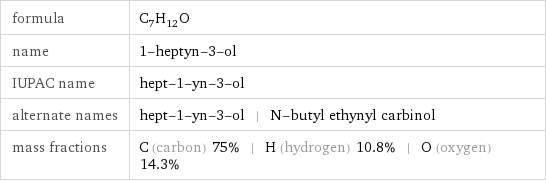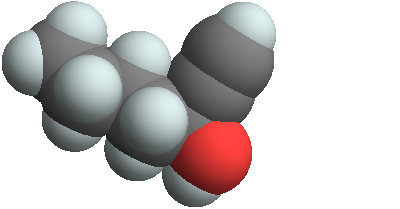Input interpretation

1-heptyn-3-ol
Chemical names and formulas

formula | C_7H_12O name | 1-heptyn-3-ol IUPAC name | hept-1-yn-3-ol alternate names | hept-1-yn-3-ol | N-butyl ethynyl carbinol mass fractions | C (carbon) 75% | H (hydrogen) 10.8% | O (oxygen) 14.3%
Lewis structure

Draw the Lewis structure of 1-heptyn-3-ol. Start by drawing the overall structure of the molecule, ignoring potential double and triple bonds: Count the total valence electrons of the carbon (n_C, val = 4), hydrogen (n_H, val = 1), and oxygen (n_O, val = 6) atoms: 7 n_C, val + 12 n_H, val + n_O, val = 46 Calculate the number of electrons needed to completely fill the valence shells for carbon (n_C, full = 8), hydrogen (n_H, full = 2), and oxygen (n_O, full = 8): 7 n_C, full + 12 n_H, full + n_O, full = 88 Subtracting these two numbers shows that 88 - 46 = 42 bonding electrons are needed. Each bond has two electrons, so in addition to the 19 bonds already present in the diagram add 2 bonds. To minimize formal charge carbon wants 4 bonds. Identify the atoms that want additional bonds and the number of electrons remaining on each atom: Fill in the 2 bonds by pairing electrons between adjacent highlighted atoms: Answer: | |
3D structure

3D structure
Basic properties

molar mass | 112.17 g/mol phase | liquid (at STP) boiling point | 162 °C density | 0.85 g/cm^3
Units

Liquid properties (at STP)

density | 0.85 g/cm^3 refractive index | 1.44
Units

Chemical identifiers

CAS number | 7383-19-9 PubChem CID number | 93050 PubChem SID number | 24884875 SMILES identifier | CCCCC(C#C)O InChI identifier | InChI=1/C7H12O/c1-3-5-6-7(8)4-2/h2, 7-8H, 3, 5-6H2, 1H3 MDL number | MFCD00041597
Safety properties

flash point | 58.89 °C

DOT numbers | 1987